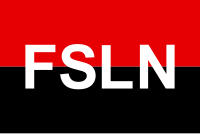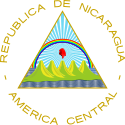Sandinista National Liberation Front
- العربية
- Aragonés
- Беларуская
- Български
- Català
- Čeština
- Dansk
- Deutsch
- Ελληνικά
- Español
- Esperanto
- Euskara
- فارسی
- Français
- Galego
- 한국어
- हिन्दी
- Hrvatski
- Ido
- Bahasa Indonesia
- Interlingua
- Ирон
- Íslenska
- Italiano
- עברית
- ქართული
- Latviešu
- Lietuvių
- Magyar
- Bahasa Melayu
- Nederlands
- 日本語
- Norsk bokmål
- Norsk nynorsk
- Polski
- Português
- Română
- Русский
- Simple English
- Slovenčina
- Српски / srpski
- Srpskohrvatski / српскохрватски
- Suomi
- Svenska
- Tagalog
- தமிழ்
- Türkçe
- Українська
- Tiếng Việt
- 吴语
- 中文
This article needs additional citations for verification. Please help improve this article by adding citations to reliable sources. Unsourced material may be challenged and removed. Find sources: "Sandinista National Liberation Front" – news · newspapers · books · scholar · JSTOR (June 2019) (Learn how and when to remove this template message) |
Sandinista National Liberation Front Frente Sandinista de Liberación Nacional | |
|---|---|
 | |
| Abbreviation | FSLN |
| President | Daniel Ortega |
| Vice President | Rosario Murillo |
| National Assembly Leader | Gustavo Porras Cortés [es] |
| Founder |
|
| Founded | 19 July 1961; 62 years ago (19 July 1961) |
| Headquarters | Leal Villa De Santiago De Managua, Managua |
| Newspaper | La Voz del Sandinismo |
| Youth wing | Sandinista Youth |
| Women's wing | AMNLAE |
| Membership (1990) | <95,700[1][needs update] |
| Ideology | |
| Religion | Christianity[a] |
| Regional affiliation | Parliamentary Left Group (Central American Parliament) |
| Continental affiliation | São Paulo Forum COPPPAL |
| Union affiliate | Sandinista Workers' Centre |
| Colors | Official: Red Black Customary: Carmine red |
| National Assembly | 75 / 90 |
| Central American Parliament | 15 / 20 |
| Flag | |
 | |
| Website | |
| www | |
The Sandinista National Liberation Front (Spanish: Frente Sandinista de Liberación Nacional, FSLN) is a left-wing political party in Nicaragua. Its members are called Sandinistas (Spanish pronunciation: [sandiˈnistas]) in both English and Spanish. The party is named after Augusto César Sandino, who led the Nicaraguan resistance against the United States occupation of Nicaragua in the 1930s.[19]
The FSLN overthrew Anastasio Somoza Debayle in the 1979 Nicaraguan Revolution, ending the Somoza dynasty, and established a revolutionary government in its place.[20][21] Having seized power, the Sandinistas ruled Nicaragua from 1979 to 1990, first as part of a Junta of National Reconstruction. Following the resignation of centrist members from this Junta, the FSLN took exclusive power in March 1981. They instituted literacy programs, nationalization, land reform, and devoted significant resources to healthcare, but came under international criticism for human rights abuses, including mass execution and oppression of indigenous peoples.[22][23] They were also criticized for mismanaging the economy and overseeing runaway inflation.[24]
A US-backed group, known as the
History
Origin of the term Sandinista
The Sandinistas took their name from Augusto César Sandino (1895–1934), the leader of Nicaragua's nationalist rebellion against the US occupation of the country during the early 20th century (ca. 1922–1934). The suffix "-ista" is the Spanish equivalent of "-ist".
Sandino was assassinated in 1934 by the Nicaraguan National Guard (Guardia Nacional), the US-equipped police force of Anastasio Somoza, whose family ruled the country from 1936 until they were overthrown by the Sandinistas in 1979.[19]
Precursor to Revolution (1933–1961)
The second U.S intervention in Nicaragua ended when
During the 1960's leftist ideas began spreading throughout the world sparking independence movements in different colonial territories. On 1 January 1959 in Havana, Cuban revolutionaries fought against dictator Fulgencio Batista. In Algeria the Algerian National Liberation Front was founded to fight against French colonial control. In Nicaragua different movements that opposed the Somoza dynasty began to unite, forming the Nicaraguan National Liberation Front which would later be renamed the Sandinista National Liberation Front.
The economic situation of Nicaragua, in the middle of the 20th century, had deteriorated as the prices of agricultural exports such as cotton and coffee dropped. Politically the conservative party of Nicaragua split and one of the factions, the Zancudos, began collaborating with the Somoza regime.
Anastasio Somoza Garcia was assassinated by poet Rigoberto Lopez Perez in 1956.
In 1957 Carlos Fonseca Amador, Silvio Mayorga, Tomás Borge, Oswaldo Madriz y Heriberto Carrillo formed the first cell of the Nicaraguan Revolutionary Committee who identified with the issues of the proletariat. Later that October, the Mexican cell was formed with members such as Edén Pastora Gómez, Juan José Ordóñez, Roger Hernández, Porfirio Molina y Pedro José Martínez Alvarado.
On October 1958 Ramon Raudales began his guerilla war against the Somoza dynasty beginning the armed conflict.
June 1959 the event known as "El Chaparral" occurred in Honduran territory bordering Nicaragua. The guerrilla fighters "Rigoberto López Pérez"[36] under the command of Rafael Somarriba (in which Carlos Fonseca was integrated) was found and annihilated by the Honduran Army in coordination with the intelligence services of the Nicaraguan National Guard.
After "El Chaparral", several more armed rebellions took place. In August the journalist Manuel Díaz y Sotelo died; in September Carlos "Chale" Haslam died; in December Heriberto Reyes (Colonel of the Defensive Army of National Sovereignty) died. The following year the events of "El Dorado" (February 28, 1960) took place where several events occurred[37] leading to several deaths including Luis Morales, Julio Alonso Leclair (head of the September 15 column), Manuel Baldizón and Erasmo Montoya.
The conventional opposition, up to that point led by the Nicaraguan Communist Party, had not been able to form a common front against the dictatorship. The opposition to the dictatorship was established around various student organizations. Among its leaders, Carlos Fonseca Amador in the early 1960s.
At the start of 1961 the New Nicaragua Movement (NNM) was founded by prominent leaders in education like Carlos Fonseca, Silvio Mayorga, Tomás Borge, Gordillo, Navarro y Francisco Buitrago; prominents leaders on workers issues such as Jose Benito Escobar; countryside leaders like Germán Pomares and small business leaders such as Julio Jerez Suárez. Legendary guerilla veteran Santos Lopez, who fought with Augusto Cesar Sandino, also participated in the NNM.
The New Nicaragua Movement was established in three cities Managua, Leon and Estelí, however they were generally stationed in Honduras. Their first public activity was held in March 1961, in support of the Cuban revolution and in protest of the position that the Nicaraguan government held with Cuba. The NNM later dissolved to make way for the National Liberation Front.
The New Nicaragua Movement soon dissolved with its members forming the National Liberation Front, FLN.
Founding (1961–1970)
 | |||||||||||||||||||||||||||||||||||||||||||||||||||||||||||||||||||||||||||||||||||||||||||||||||||||||||||||
|---|---|---|---|---|---|---|---|---|---|---|---|---|---|---|---|---|---|---|---|---|---|---|---|---|---|---|---|---|---|---|---|---|---|---|---|---|---|---|---|---|---|---|---|---|---|---|---|---|---|---|---|---|---|---|---|---|---|---|---|---|---|---|---|---|---|---|---|---|---|---|---|---|---|---|---|---|---|---|---|---|---|---|---|---|---|---|---|---|---|---|---|---|---|---|---|---|---|---|---|---|---|---|---|---|---|---|---|---|---|
|
Executive |
|||||||||||||||||||||||||||||||||||||||||||||||||||||||||||||||||||||||||||||||||||||||||||||||||||||||||||||
|
Legislature |
|||||||||||||||||||||||||||||||||||||||||||||||||||||||||||||||||||||||||||||||||||||||||||||||||||||||||||||
|
Administrative divisions |
|||||||||||||||||||||||||||||||||||||||||||||||||||||||||||||||||||||||||||||||||||||||||||||||||||||||||||||
|
|||||||||||||||||||||||||||||||||||||||||||||||||||||||||||||||||||||||||||||||||||||||||||||||||||||||||||||
|
|
|||||||||||||||||||||||||||||||||||||||||||||||||||||||||||||||||||||||||||||||||||||||||||||||||||||||||||||
|
| |||||||||||||||||||||||||||||||||||||||||||||||||||||||||||||||||||||||||||||||||||||||||||||||||||||||||||||
| |||||||||||||||||||||||||||||||||||||||||||||||||||||||||||||||||||||||||||||||||||||||||||||||||||||||||||||





